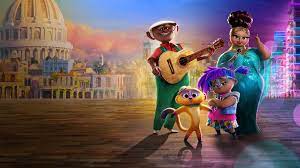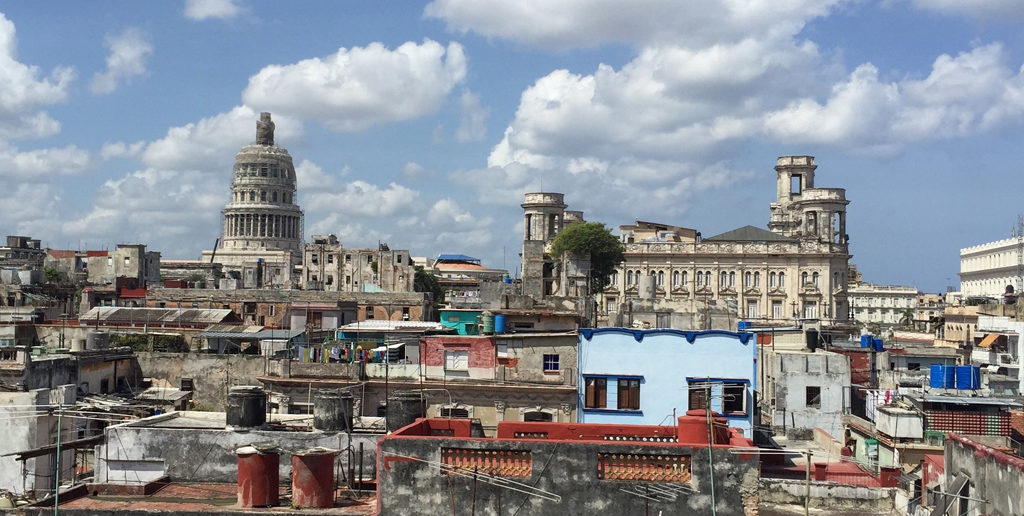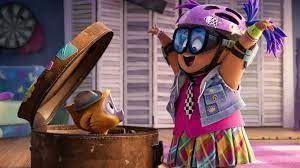MENSAJE HABANERO: NETFLIX ANIMATED “VIVO” RETURNS TO HAVANA, CUBA. VIDEOS.
By Reynaldo Lastre (El Toque), La Havana.
ON AUGUST 6th, Netflix included “Vivo”, another movie about Cuba, in its trimester movie lineup. In 2016, Vientos de La Habana (Félix Viscarret) was featured, an adaptation of one of the most well-known novels written by Leonardo Padura, in connection with the documentary miniseries The Cuba Libre Story. A year later, Netflix added Cuba and the Cameraman, the documentary that summarizes Cuban history post-1959, with the systematic trips US journalist Jon Alpert made to the island over 45 years. In 2019, it showed La red Avispa (Olivier Assayas), inspired by the spy network that resulted in one of Fidel Castro’s last ideological campaigns.
“Vivo” seems to distance itself from this distinct historic and sociological tradition, as it is targeted towards a child audience. It is an animated movie produced by Sony and conceived for the big screen, but setbacks due to the pandemic led to an exhibition and distribution contract with the online platform.
 VIDEOS – “VIVO” ANIMATED FROM NETFLIX (TRAILER)
VIDEOS – “VIVO” ANIMATED FROM NETFLIX (TRAILER)
THE REAL MARTA SANDOVAL FROM CUBA
The story of Andrés (Juan de Marcos González) and Marta (Gloria Estefan), a successful musical duo on the Cuban music scene during the Republic, parts ways when the versatile singer accepts a job in Florida. After more than 60 years of silence, Marta writes to Andres – who is earning a living as a street musician in Old Havana’s squares, alongside his small pet – inviting him to what will be her last concert.
The letter stirs Andres’ buried feelings for Marta in their youth, to the point that he dusts off the lyrics to an old song in which he confesses his love, with the hope of getting a second chance. The little kinkajou who Andres calls Vivo (voiced by Lin-Manuel Miranda) is against the plan when he realizes it could uproot his life. However, with Andres’ unexpected death, Vivo decides to hand the song lyrics to the addressee, as a means to honor the memory of the man who was his owner and protector.
In addition to the often-sought strategies of US animated movies recently: a story of friendship between humans and animals, musical interludes with choreographies, the constant journey of the hero, etc., Vivo’s story gains particular interest with its reimagination of Havana and Miami, and its subliminal strategy of showing the lives of less visible Cuban immigrants.
The Cuban city is the protagonist of the first 25 minutes of the movie. Even though it is an animated movie, the Havana shown here is more in line with the city during Barack Obama’s presidency. Images of US tourists walking down the city’s streets alongside the idea of a joyful, festive, and colorful city, circulated at the time via music videos, postcards, and movies set on the island.
However, the most interesting thing is the political friction that escapes the main stage and is hidden in references or metaphors in the story. At the beginning, you hear the narrator say: “these kids have a perfect life”; while, at another time, Vivo tells Andres that they are ordinary people, not the Miami people, revealing a clear ideological contrast.
The movie’s set design doesn’t leave the perimeter of Old Havana, where only almendrones (1950’s US Cars), tourists, and town criers move around. Almost all of the Cubans that appear are mulato, and they all know each other well or are familiar with each other, they are generous and live to the compas (beat) of popular music.
When Andres reads the letter on the Malecon for the first time, all of the passers-by are surprised when he reads Marta’s name, as if the passage of time hadn’t put a dent in the memory of her golden days.
People’s reaction when the old man stammers about going to Miami or not is even more extraordinary. They all deduce that it is a financial problem and improvise a collection; which not only implies that Cubans can travel to the US freely (if they have money for a plane ticket), but also that a spontaneous collection on the street is able to solve this problem.
On the other hand, the movie’s scenes in Miami are full of modern cars and buildings, neon lights, and references to technology and the Internet. While the contrast between the two cities seems to stem from a political clash, it’s clear that a North-South comparison exceeds this. However, Vivo, the pet who becomes the story’s real protagonist, offers the real key to a political interpretation of the movie.
KINKAJOU: A CUBAN ANIMAL?
In spite of kinkajous not being native to Cuba, but are instead native to the Central American jungle, their inclusion in the movie suggests a second reading about Cuba and the Cuban people. While the old man only needs a plane ticket to go to the US, Vivo has to travel illegally.
After meeting Gaby, a little Cuban-American girl who was visiting the island, he gets the opportunity to leave for Florida in one of her suitcases. Once at Gaby’s home with her mother, in Cayo Hueso, Vivo must travel to Miami in order to give Marta the song and thereby fulfill his mission.
Due to Gaby’s mother’s refusal to take them in the car and it being impossible to take a local bus, Vivo, Gaby, and other girls join them on an adventure and travel through the Everglades. The trip becomes dangerous, full of attacks by deadly animals and short-tempered storms, which is an indirect reference to the journey that Cuban migrants embark on through the Darien Gap. In the end, it’s interesting that Vivo (who adamantly refused to leave the island in the beginning and then insinuates his desire to return) ends up working as a street musician in Florida.
The role Vivo plays (a small, educated animal who is intelligible to viewers just by talking, (but not to those who surround him) points out that the existence of a kind of Cuban in the Obama period that we’re unable to speak. The movie thereby becomes a metaphor of a Cuban who, is still the protagonist of many stories but ends up being crushed by the circulation of narratives of a more pleasing and sophisticated Cuban-ness.
MENSAJE HABANERO: NETFLIX ANIMADO “VIVO” REGRESA A LA HABANA, CUBA. VIDEOS.
Por Reynaldo Lastre (El Toque), La Habana.
EL 6 DE AGOSTO, Netflix incluyó “Vivo”, otra película sobre Cuba, en su cartel trimestral. En 2016 se presentó Vientos de La Habana (Félix Viscarret), adaptación de una de las novelas más conocidas de Leonardo Padura, en conexión con la miniserie documental The Cuba Libre Story. Un año después, Netflix agregó Cuba and the Cameraman, el documental que resume la historia de Cuba posterior a 1959, con los viajes sistemáticos que el periodista estadounidense Jon Alpert realizó a la isla durante 45 años. En 2019 mostró La red Avispa (Olivier Assayas), inspirada en la red de espías que resultó en una de las últimas campañas ideológicas de Fidel Castro.
“Vivo” parece distanciarse de esta tradición histórica y sociológica distintiva, ya que está dirigido a un público infantil. Se trata de una película de animación producida por Sony y concebida para la gran pantalla, pero los contratiempos provocados por la pandemia llevaron a un contrato de exhibición y distribución con la plataforma online.
 VIDIEOS- NETFLIX “VIVO” UN CARTOON ANIMADO (AVANCES)
VIDIEOS- NETFLIX “VIVO” UN CARTOON ANIMADO (AVANCES)
LA REAL MARTA SANDOVAL DE CUBA
La historia de Andrés (Juan de Marcos González) y Marta (Gloria Estefan), un exitoso dúo musical en la escena musical cubana durante la República, se separa cuando el polifacético cantante acepta un trabajo en Florida. Después de más de 60 años de silencio, Marta le escribe a Andrés -quien se gana la vida como músico callejero en las plazas de La Habana Vieja, junto a su pequeña mascota- invitándolo al que será su último concierto.
La carta despierta los sentimientos enterrados de Andrés por Marta en su juventud, hasta el punto de desempolvar la letra de una vieja canción en la que confiesa su amor, con la esperanza de tener una segunda oportunidad. El pequeño kinkajou que Andrés llama Vivo (con la voz de Lin-Manuel Miranda) está en contra del plan cuando se da cuenta de que podría desarraigar su vida. Sin embargo, ante la inesperada muerte de Andrés, Vivo decide entregar la letra de la canción al destinatario, como una forma de honrar la memoria del hombre que fue su dueño y protector.
Además de las estrategias frecuentemente buscadas de las películas de animación estadounidenses recientemente: una historia de amistad entre humanos y animales, interludios musicales con coreografías, el viaje constante del héroe, etc., la historia de Vivo cobra especial interés con su reimaginación de La Habana y Miami. , y su estrategia subliminal de mostrar la vida de inmigrantes cubanos menos visibles.
La ciudad cubana es la protagonista de los primeros 25 minutos de la película. Aunque es una película animada, la Habana que se muestra aquí está más en línea con la ciudad durante la presidencia de Barack Obama. Imágenes de turistas estadounidenses caminando por las calles de la ciudad junto con la idea de una ciudad alegre, festiva y colorida, circularon en ese momento a través de videos musicales, postales y películas ambientadas en la isla.
Sin embargo, lo más interesante es el roce político que se escapa del escenario principal y se esconde en referencias o metáforas en la historia. Al principio, se escucha al narrador decir: “estos niños tienen una vida perfecta”; mientras que, en otro momento, Vivo le dice a Andrés que son gente común, no la gente de Miami, revelando un claro contraste ideológico.
La escenografía de la película no abandona el perímetro de La Habana Vieja, donde solo se mueven los almendrones (coches estadounidenses de los años 50), turistas y pregoneros. Casi todos los cubanos que aparecen son mulatos, y todos se conocen bien o se conocen, son generosos y viven al compás de la música popular.
Cuando Andrés lee la carta en el Malecón por primera vez, todos los transeúntes se sorprenden al leer el nombre de Marta, como si el paso del tiempo no hubiera hecho mella en el recuerdo de sus días dorados.
La reacción de la gente cuando el viejo tartamudea sobre ir o no a Miami es aún más extraordinaria. Todos deducen que se trata de un problema económico e improvisan una colección; lo que no solo implica que los cubanos pueden viajar a Estados Unidos libremente (si tienen dinero para un boleto de avión), sino que también una recaudación espontánea en la calle es capaz de solucionar este problema.
Por otro lado, las escenas de la película en Miami están llenas de automóviles y edificios modernos, luces de neón y referencias a la tecnología e Internet. Si bien el contraste entre las dos ciudades parece provenir de un choque político, está claro que una comparación Norte-Sur supera esto. Sin embargo, Vivo, la mascota que se convierte en el verdadero protagonista de la historia, ofrece la verdadera clave para una interpretación política de la película.
KINKAJOU: ¿UN ANIMAL CUBANO?
A pesar de que los kinkajous no son nativos de Cuba, sino que son nativos de la jungla centroamericana, su inclusión en la película sugiere una segunda lectura sobre Cuba y el pueblo cubano. Mientras que el anciano solo necesita un boleto de avión para ir a Estados Unidos, Vivo tiene que viajar ilegalmente.
Después de conocer a Gaby, una pequeña cubanoamericana que estaba de visita en la isla, tiene la oportunidad de partir hacia Florida en una de sus maletas. Una vez en casa de Gaby con su mamá, en Cayo Hueso, Vivo debe viajar a Miami para entregarle la canción a Marta y así cumplir con su misión.
Debido a que la madre de Gaby se niega a llevarlas en el automóvil y es imposible tomar un autobús local, Vivo, Gaby y otras chicas se unen a ellas en una aventura y viajan por los Everglades. El viaje se vuelve peligroso, lleno de ataques de animales mortales y tormentas de mal genio, lo que es una referencia indirecta al viaje que emprenden los migrantes cubanos por el Darién Gap. Al final, es interesante que Vivo (quien al principio se negó rotundamente a dejar la isla y luego insinúa su deseo de regresar) termine trabajando como músico callejero en Florida.
El papel que juega Vivo (un animal pequeño, educado que es inteligible para los espectadores con solo hablar, pero no para quienes lo rodean) señala que la existencia de una especie de cubano en la época de Obama que no podemos hablar. La película se convierte así en una metáfora de un cubano que, aún protagonista de muchas historias, acaba aplastado por la circulación de narrativas de una cubanía más placentera y sofisticada.
Agencies/ HavanaTimes/ Reynaldo Lastre(El Toque)/ Internet Photos/ YouTube/ Arnoldo Varona/ www.TheCubanHistory.com
THE CUBAN HISTORY, HOLLYWOOD.












